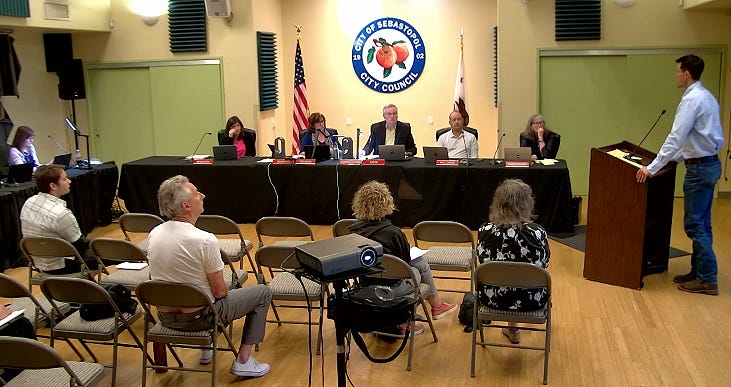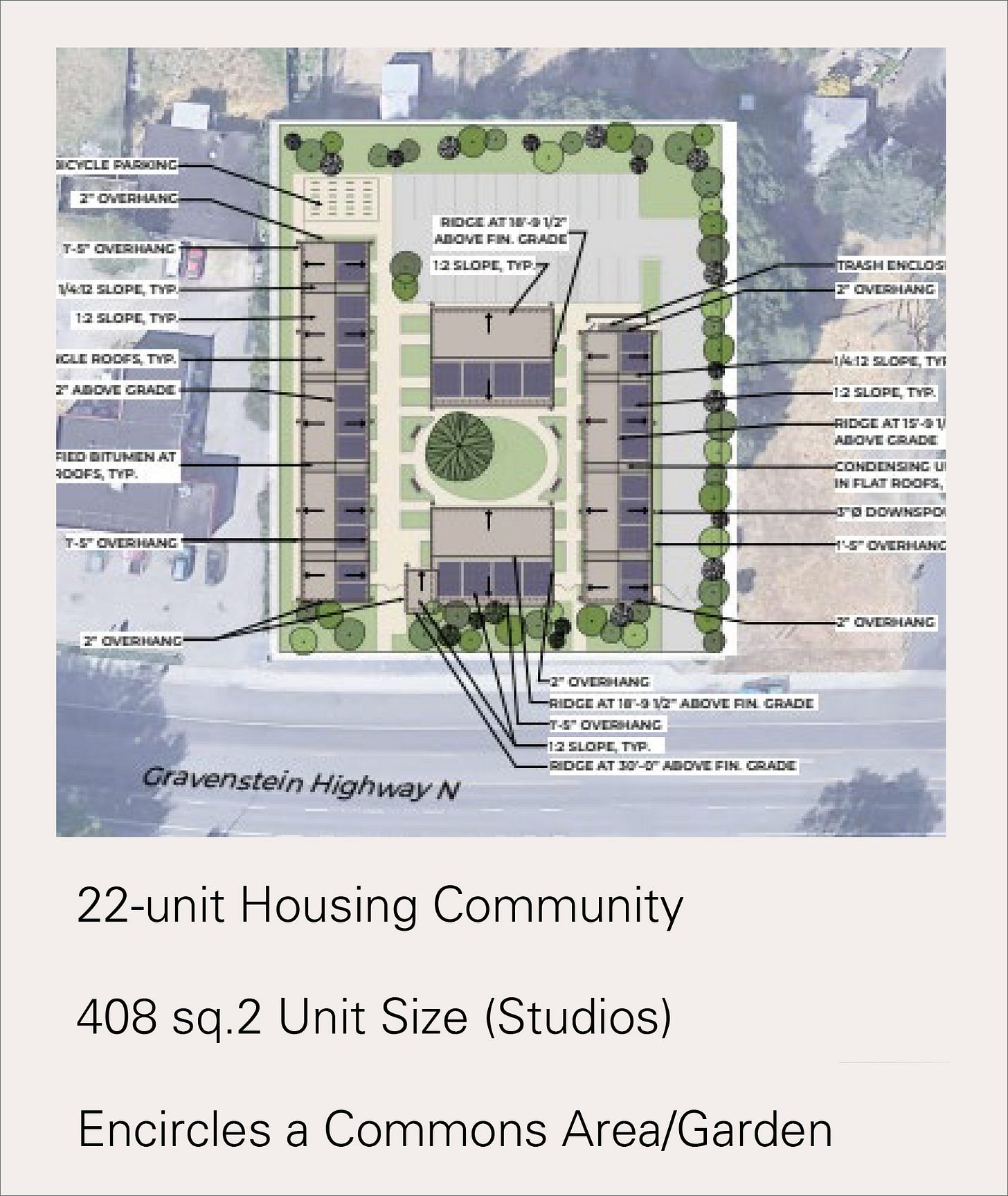What's happening with Gravenstein Commons?
Part 1: The new permanent supportive housing complex for the homeless is scheduled to open next spring. Will resident and neighborhood councils prevent problems?

Initial site work has begun on Gravenstein Commons, a permanent supportive housing complex for the homeless being built across from the Redwood Shopping Center on the north end of town.
Jack Tibbetts, executive director of Saint Vincent de Paul Sonoma County, which is the developer of the project, appeared before the Sebastopol City Council to give an update on the project and answer community concerns prompted by the rough start at Elderberry Commons, a Project Homekey site that opened earlier this year.
After a brief review of the project—Gravenstein Commons is a 22-unit housing community made up of 408-square-foot studio apartments—Tibbett’s leapt right in with a description of security measures.
“There will be a resident manager with experience who lives there 24/7, 365 days a year. We do have security cameras and a privacy wall—this is honestly more for the tenants than it is for everybody else—and we have 1.4 full-time-equivalent case managers, so there will be someone there five days a week and then an additional two days on the weekend.”
Just for comparison, there is no resident manager at Elderberry Commons and the case workers are only there during the week.
Tibbetts also noted that there would be private, unarmed guards for the first six to 12 months “to provide that sense of authority and oversight” and a zero-tolerance policy towards violence, which would be grounds for immediate eviction. In addition, overnight guests would be limited to 10 days a year, and they have an “Orderly Community Policy” that prohibits hoarding and the accumulation of trash, which are also grounds for eviction.
Like Elderberry Commons, units at Gravenstein Commons will be reserved for the county’s “most vulnerable” homeless people—people who score a 9 or 10 on the county’s vulnerability index—which includes the elderly, disabled, and women, but also the mentally ill and people with severe substance abuse issues that make it difficult for them to function, not merely in society, but even within the protected confines of homeless housing.
He realizes this is frustrating for the community. Echoing comments he made to the Sebastopol Times in June, he said, “Behind every single person who is taking up that housing unit, here's a litany of people behind them who really want that spot. But again, that’s not something Saint Vincent DePaul has any way to influence, to do or not to do — that is a requirement that we’re both [meaning Elderberry and Gravenstein Commons] held to under the standard agreement with HCD [Housing and Community Development].”
Can a resident council and a neighborhood advisory council lessen the negative impacts on the community?
Tibbetts suggested creating both a resident council and a neighborhood advisory council for Gravenstein Commons. Saint Vincent de Paul created both of these when it ran Los Guilicos Village near Oakmont.
“One thing that we do is we have a resident council. So any of the tenants who live there, we ask them to elect a certain number of people—just like a council that you are—to help shape policy decisions on the grounds and also make budget expenditures for things like improvements around the property or tenant enrichment experiences.”
“In the case of Oakmont, we established a Neighborhood Advisory Council, and we asked some of the most concerned, most vocal residents to join us on a council that would help shape policy for the entire community that was being introduced into their neighborhood next door.”
Tibbetts said this approach makes for better policies, but also “provides transparency for some of your most concerned community members…I would propose that we try that here.”
Calling this approach “the thing I’m the most proud of that Saint Vincent de Paul has done in my 10-year tenure with the organization,” Tibbetts said of this approach, “It's really unique, it's really adaptive, and it really helps both the residents and the community thrive.”
A financial tightrope
Tibbetts then gave a quick summary of the finances of the project:
Total construction budget: $7,011,558
Total raised-to-date: $6,784,000
Gap: $195,335
In partnership with the city of Sebastopol, Saint Vincent de Paul (SVdP) received $6,449,000 from a Project Homekey grant from the California Department of Housing and Community Development. SVdP has since raised $335,000 in private donations for the project.
From there, it gets a little murky. The county’s previous Health and Human Services Director Tina Rivera had promised SVdP $3 million in county support, but that seems to be in question since her departure. Her replacement Nolan Sullivan tried and failed to get a $990,000 HHAP and TAY turnback funding request on the August Supervisor’s agenda. Tibbetts wrote in his report to the city, “That said, however, the County is aware of our need, they are aware of their obligation, as outlined in the commitment letter, and they are actively referring us to funding opportunities via the NOFA process. SVdP is currently applying for $1,000,000 through the Measure O NOFA, with award announcements expected to be made in November of 2025. Separately, according to Supervisor Lynda Hopkins, the County is exploring another NOFA using HHAP 3 turnback funds.”
For those, like me, who need an acronym translator:
NOFA stands for Notice of Funding Availability.
HHAP 3 “turnback funds” refer to the portion of Homeless Housing, Assistance and Prevention (HHAP) Round 3 grant funding that was returned to the state of California by recipients who failed to meet spending deadlines. If a grantee misses the spending deadline for their HHAP 3 funds, HCD can reclaim and reallocate the money to other qualified entities.
TAY turnback funds refer to funding that is reverted to the state and reallocated for services for Transition Aged Youth.
Should all these efforts fail, Tibbetts said SVdP would pay for the $195,335 construction cost gap with its line of credit. Councilmember Maurer inquired if they could use the interest on the $6,449,000—around $146,000—to close the gap. Tibbetts said yes, that was the plan.
During council questioning, Councilmember Phill Carter asked about operating expenses.
Tibbetts explained that “The $671,000 operating subsidy is a chunk of that $6,449,000, and that is money that we are eligible to use if, at the end of construction, we have a surplus to subsidize the operation of it. It's not money that we want to use. To be quite honest, it'd be better to use it towards construction, because our whole model is that we use section eight housing vouchers to provide a sustainable source of funding for the entire operational costs.”
Tibbetts also noted that “The Trump administration has said they're going to do a 45% reduction to housing voucher funding across the United States, but that has not been determined yet.”
Vice Mayor Jill McLewis asked what that would mean for SVdP ability to operate the project.
“If the administration is going to cut everything by 45%, we looked at our projected income, which I believe was just shy of $500,000. That would drop us down to $260,000 in income. We can still operate off of $260,000, though that is not to our standard. That's not what we would like to do.”
McLewis pushed him on this, asking what this would entail. He said they would probably cut back on maintenance first, since as a new building there would be less need for maintenance, and if things get really dire, they’d cut back on case manager hours.
He also said that, should such drastic cuts come through, “I think that the governor with the Director of Housing and Community Development would start to either allow suspension of certain clauses in the standard agreement, like the requirement that you have all these various things. They might even look at allowing some of the units to be rented at market rate. We don't know.”
In the end, though, he said, “I am pretty optimistic that nothing is going to really threaten the financial viability of the project.”
Mayor Stephen Zollman challenged Tibbetts on whether SVdP’s onsite staff were licensed clinicians. They aren’t.
Tibbetts responded, “We do make sure that our residents have access to an abundance of licensed clinicians, notably the Providence Street Outreach Nurse team, and they work directly with a medical director who is able to provide prescription medication…I want to be abundantly clear, Mr. Zollman, we do make sure that our residents have access to medical care.”
There was also an oddly heated discussion of the city’s plan to draft a good neighbor policy for homeless housing facilities. Vice Mayor McLewis said she didn’t think SVdP should be included in the drafting of such a policy. Hinton noted that it was common to include city partners in the drafting of policies that affect them. Zollman seemed to suggest that SVdP was opposed to having a good neighbor policy. Tibbetts said he wasn’t opposed, but he’d like to know what was in it.
“Let me be clear, if you're passing an ordinance that applies universally, we are going to adhere to your town's ordinance,” Tibbetts said. “We’re not going to flout it, but I think it is always great to reach out to your partners and have those discussions in advance.”
Part 2 of this article will discuss further how residents are chosen for Gravenstein Commons (including the possibility of housing local Sebastopol homeless individuals), SVdP’s policy toward families with children, and comments from the public and the council.



This seems to be progress on addressing the needs of people who have fallen through the cracks, large ones, in our society’s ability to accommodate the needs of everyone. IMO, part of the requirement for any resident is to first get addiction and sexual abuse therapy. Alcoholics, cocaine and opioid dependent people, and sexual abusers (this, to me, includes sex workers) should simply not be allowed amongst the inhabitants. They should be provided separate homes in a more controlled environment, with medical and addiction therapy staff on duty at all times.
Those meeting those requirements should not be subjected to such a controlled environment.
Education and job training, along with job referral programs, should also be a part of this. Programs enabling them to create,their own businesses would also be helpful, as getting jobs is not easy for most of us.
Homelessness is a dynamic problem requiring dynamic solutions. Just giving a place to live has not worked. This plan sounds like a step in the right direction, to me.